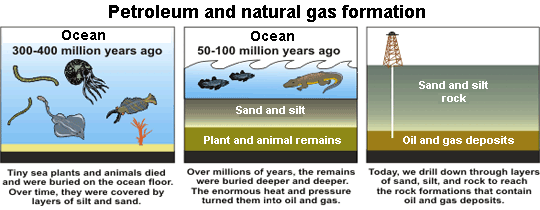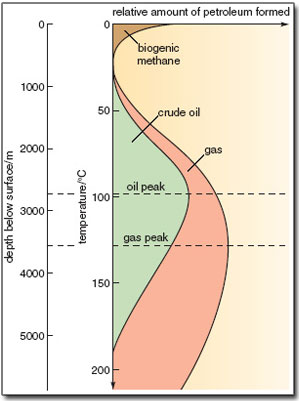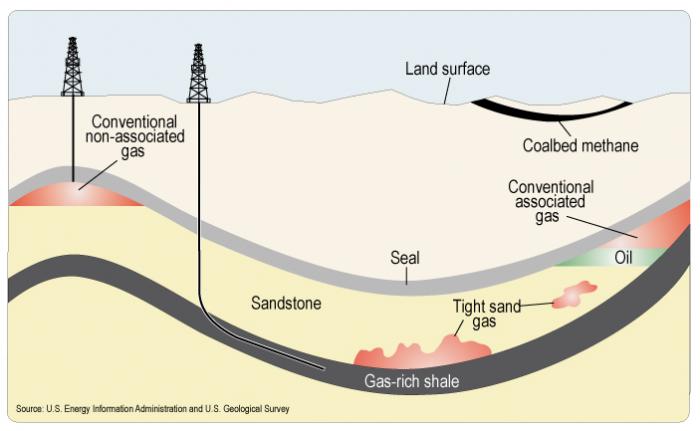Oil and Natural Gas Formation
Coal, oil and natural gas typically form in sedimentary rocks. When carbon-rich organic materials, such as leaves, are deposited in stagnant water such as a bog or swamp with a low oxygen content it may not fully decay. If this happens and sediment is deposited on top, a coal bed can eventually form. Many of the largest coal beds in the world are a result of huge Devonian and Carboniferous-age swamps. Similarly, oil and gas are formed when organic material is deposited in marine sediments where the organic material consists mostly of microscopic organisms that convert sunlight into energy such as phytoplankton, dinoflagellates, and/or radiolaria. Plant material such as algae and pollen is another primary source of organic material that is converted into oil and gas. When these organisms and plant materials die and settle to the ocean floor some of this energy remains in the form of carbon molecules in their bodies. Other elements that settle to the ocean floor are nitrogen, oxygen, and hydrogen. All of these molecules mix with very fine-grained sediment and form an organic-rich ‘ooze’. As sediments continue to be deposited, burying the ooze (remember burial is vital to preservation!), the weight of the overlying sediment will cause an increase in temperature and pressure, which will, in turn, lithify the ooze (i.e., turn it into stone) and convert the organic material into kerogen and ultimately oil and natural gas.
In this video clip, Dr. Terry Engelder describes the depositional environment in which organic-rich shales are deposited.
Video: Depositional Setting for Shale, Terry Engelder (1:48)
Dave Yoxtheimer: From a geologic perspective, what is the best depositional setting for shale gas to form?
Terry Engelder: Basins form as catchments for sediments, and these sediments can be carbonates, they can be sandstones, they can be shale, and shale often consists of a combination of carbonates plus clastic rocks. And the important thing about shales is that most shales are nonorganic. And so there is a very special set of conditions on the ocean floor that are necessary to preserve organic matter, which then can be captured in shale, and those conditions require the absence of oxygen. And the absence of oxygen happens occasionally in enclosed basins, which means that water doesn't flow in and out of those basins freely. And the basins are deep enough so that windblown circulation of water does not take place down in the deeper portions of the basins, while organic matter is being carried into the basin along with sediments, and the organic matter and sediments are buried over time, in an environment that is without oxygen. And in effect then, the organic matter is preserved because without oxygen the bacteria that would otherwise reduce the organic matter can't attack the organic matter, which happens in most ocean basins.

- Ocean (300-400 million years ago)
Tiny sea plants and animals died and were buried on the ocean floor. Over time, they were covered by layers of silt and sand. - Ocean (50-100 million years ago)
Ocean with a layer of "sand and silt", and then below that, a layer of "plant and animal remains".
Over millions of years, the remains were buried deeper and deeper. The enormous heat and pressure turned them into oil and gas. - Today
Drill on top of a layer of "sand and silt" (larger than the other layer), and then a layer of "oil and gas deposits" below that.
Today, we drill down through layers of sand, silt, and rock to reach the rock formations that contain oil and gas deposits.
The temperature, pressure, and type of organic material in the kerogen determine whether oil or gas or a mixture is formed as shown in the figure below. Type 1 kerogen is typically formed in lacustrine(lake) environments and prone to form oil, Type 2 kerogen is formed in marine environments and prone to form oil and natural gas, and Type 3 kerogen is formed from terrestrial deposits and prone to form natural gas. Relatively lower temperatures and pressures form oil, while higher temperatures and pressures form natural gas, however, a spectrum of hydrocarbons can be formed, including ethane, propane, butane, and other natural gas liquids.

In this video clip, Dr. Terry Engelder of Penn State describes what conditions make a shale formation prospective for oil and gas development.
Video: Geologic Conditions for Shale, Terry Engelder (1:14)
Dave Yoxtheimer: What geological characteristics are important to consider when developing oil and gas from shales?
Terry Engelder: There have to be several overlapping conditions for an economic gas shale. The gas shale has to have organic matter to a certain percentage. Usually, we think of 2, or 3, or 4 weight percent organic matter in the shale to make it viable. That organic matter has to be subjected to just the right temperature and right pressure for the generation of gas. If the shale is too deep, the gas is burned out, if the shale doesn't achieve depths that are at the necessary temperature, gas is not generated in the first place. The shale has to be thick enough to be economic. There are a lot of gas shales that are just thin layers and not worthwhile in terms of exploration for the industry. So, the preservation of a gas shale like the Marcellus, and an economic Marcellus, is at a depth of somewhere on the order of 2 kilometers and thickness that exceeds somewhere on the order of 20 meters, to be just right for production.
Once oil and gas are formed, the hydrocarbons become pressurized and a portion of them are able to migrate through the rock's porosity, which is the open space between grains, fractures, vesicles, and voids formed by dissolution. Geologists look for rock layers that are sufficiently impermeable and seal off the further migration of oil and gas, which become trapped in the relatively permeable underlying rock and is known as a stratigraphic trap or seal rock. When pore spaces are well connected, a rock is considered to be relatively permeable, since it is easy for liquids to flow through it. An impermeable rock will, therefore, have a low connectivity of pore spaces. A fault in a rock can also have low permeability and trap hydrocarbons in the underlying permeable rock, which is known as a structural trap. Geologists and energy companies have been producing hydrocarbons for over 100 years out of these relatively permeable formations that contain trapped hydrocarbons, which is known as a reservoir rock. Conventional formations are reservoir rocks, typically sandstones or carbonates, with sufficient porosity to store hydrocarbons that have migrated upward out of source rock, typically an organic-rich, black shale, which is where the hydrocarbons were formed (kind of like a kitchen). Where black shales retain enough hydrocarbons they are considered as both the source rock and the reservoir rock, which is considered an unconventional formation with low permeability and therefore requires hydraulic fracturing, or fracking, to extract the oil and gas from the natural gas- or oil-rich shale. Hydraulic fracturing is the process of injecting liquid at very high pressures into a rock, which causes any fractures or weak planes of the rock to open up, thus forming pathways for the oil and gas to migrate out of the low-permeability shale and flow into a well. The figure below shows the black shale layer that is the source of oil and gas in the overlying sandstone and can be drilled into, often horizontally or directionally. We will explore more on horizontal drilling and hydraulic fracturing in the next lesson.
